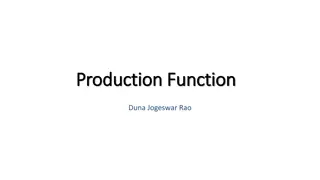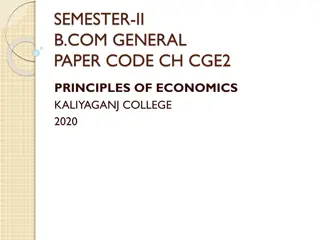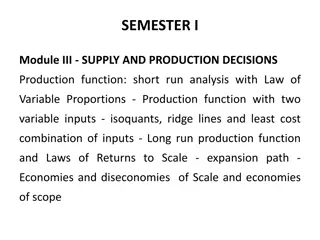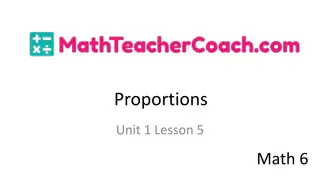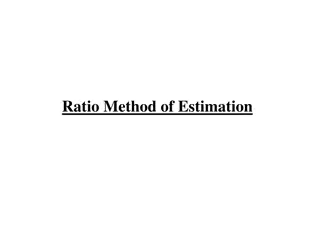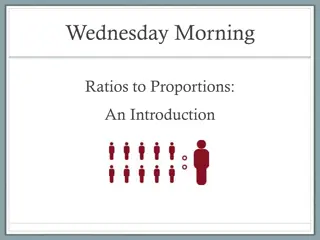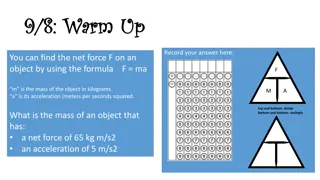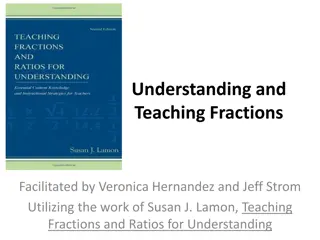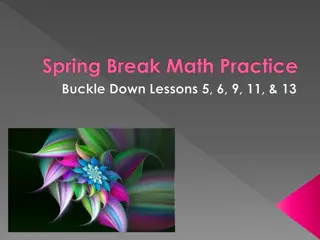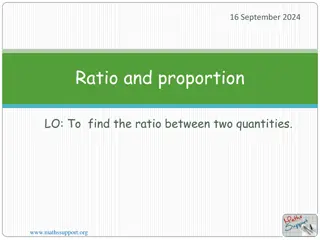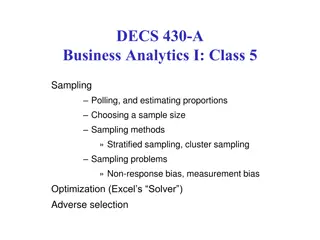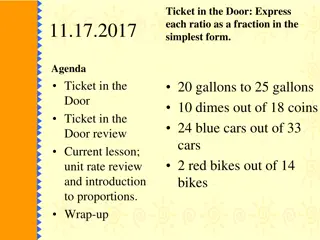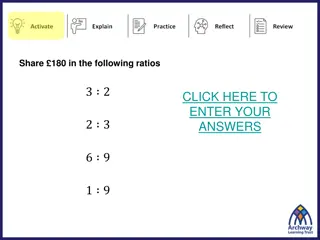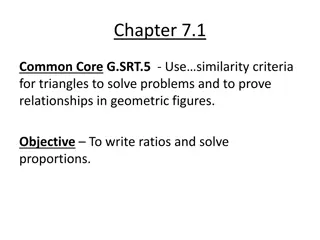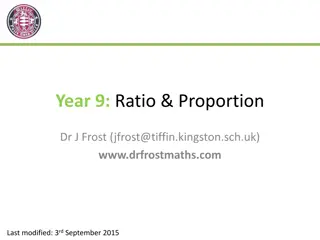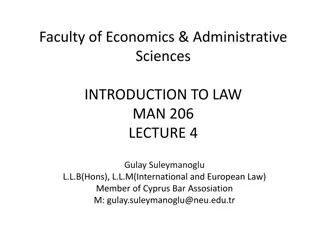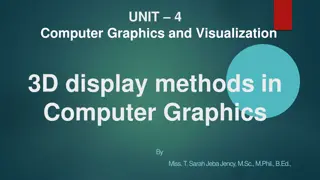Understanding the Concept of Return to Factor in Production Economics
Return to Factor is a key concept in production economics that explains the relationship between variable inputs like labor and total production output. The concept is based on the three stages of production - increasing returns, diminishing returns, and negative returns. By analyzing the behavior o
0 views • 7 slides
Concrete Mix Design: Optimal Proportions & Aggregate Gradation
Concrete mix design is crucial for achieving the desired properties and performance of concrete. The Maximum Aggregate Density Mix Design method helps determine the best proportions for Portland Cement Concrete. Utilizing combined aggregate gradation near the maximum density line can reduce shrinkag
0 views • 34 slides
Understanding Proportions and Confidence Intervals in Statistics
Explore the concept of proportions in statistics, where the parameter of interest is the percentage of a population with a specific characteristic. Learn how confidence intervals help us assess the reliability of our estimates and how to calculate them using sample statistics. Discover the importanc
0 views • 18 slides
Laws of Production in Economics
The content discusses the laws of production in economics, including the law of variable proportion in the short run and the law of returns to scale in the long run. It explains the concepts of total product, average product, and marginal product, along with the stages of production. The law of vari
0 views • 18 slides
Understanding the Production Function and Laws of Production
Production function expresses the relationship between inputs and outputs, showcasing how much can be produced with a given amount of inputs. The laws of production explain ways to increase production levels, including returns to factors, law of variable proportions, and returns to scale. The law of
2 views • 20 slides
Principles of Economics: Theory of Production and Production Functions
Explore the Principles of Economics with a focus on the Theory of Production, including the Production Function which illustrates the relationship between inputs and outputs. Learn about short run versus long run production, factors of production, and the Law of Variable Proportions. Gain insights i
0 views • 17 slides
Understanding Gas Laws: Boyle's, Charles', Gay-Lussac's, and Avogadro's Laws
Gas laws such as Boyle's Law, Charles' Law, Gay-Lussac's Law, and Avogadro's Law govern the behavior of gases under different conditions. Boyle's Law relates pressure and volume at constant temperature, Charles' Law relates volume and temperature at constant pressure, Gay-Lussac's Law relates pressu
1 views • 19 slides
Understanding Marginal Costing in Cost Accounting
Marginal Costing is a cost analysis technique that helps management control costs and make informed decisions. It involves dividing total costs into fixed and variable components, with fixed costs remaining constant and variable costs changing per unit of output. In Marginal Costing, only variable c
1 views • 7 slides
Understanding Production Function and Laws of Returns in Economics
Production function in economics involves transforming inputs into outputs and understanding the relationship between input quantities and output under a given technology state. Concepts like Total Product, Average Product, and Marginal Product are essential in analyzing production efficiency. The L
1 views • 38 slides
Understanding Proportions in Mathematics
Explore the concept of proportions in mathematics as you learn to define proportions, determine their accuracy, find unknown values, and solve problems using proportions. Key vocabulary such as ratio, proportion, cross multiplication, equality, and fractions are covered in this lesson. Practice iden
0 views • 21 slides
How to Calculate the Proportions for C10 Concrete?
Learn how to calculate the correct proportions for mixing C10 concrete. Get the right mix for your construction projects with these simple steps.\n
1 views • 6 slides
Ratio Method of Estimation in Statistics
The Ratio Method of Estimation in statistics involves using supplementary information related to the variable under study to improve the efficiency of estimators. This method uses a benchmark variable or auxiliary variable to create ratio estimators, which can provide more precise estimates of popul
0 views • 30 slides
Exploring Ratios and Proportions in an Engaging Learning Session
Dive into a dynamic learning experience focused on ratios, proportions, and pattern recognition. Engage in counting activities, memory tests, and visual challenges to strengthen your understanding of mathematical concepts. Uncover the significance of clear instructions and effective strategies in en
0 views • 37 slides
Contrasting Legal Systems Around the World
Explore the diverse legal families globally, such as Civil Law (Romano-Germanic) and Common Law (Anglo-American), along with their historical backgrounds, sources of law, and dominant ideologies. Delve into the distinctions between Civil Law and Common Law, their origins, development, and practical
0 views • 17 slides
Understanding Proportions in Physics
Exploring the concept of proportions in physics, specifically how to determine the mass of an object using the formula F = ma. Discover the relationship between force, mass, and acceleration in solving problems related to net force calculations.
0 views • 34 slides
Understanding Legal Systems and Sources of Law
Legal systems are created through factors like rules forbidding or compelling conduct, compensation for injuries, court systems, and a rule-making body. Sources of law include statutes, customs, judicial decisions, legal principles, and jurists' opinions. There are different national legal systems w
0 views • 18 slides
Understanding Combined Gas Law and Ideal Gas Law for Final Exam Preparation
Explore the concepts of Combined Gas Law, Boyle's Law, Charles's Law, Gay-Lussac's Law, and their reflection in the Ideal Gas Law. Learn how to solve problems using these laws, prepare for your final exam scheduled for Tuesday, December 12 at 12:30 in the specified room. Dive into in-class practice
1 views • 23 slides
Overview of UK Law: Statute Law, Common Law, Criminal Law, Civil Law
Statute Law is written law created through the parliamentary process, forming the basis of the legal system. Common Law, on the other hand, is unwritten law based on judicial decisions and precedents. They govern different aspects such as civil and criminal matters, each with its unique characterist
0 views • 15 slides
Load Following by Nuclear Power Plants in Relation to Variable Renewable Energies' Development
The study explores the requirements of load following by nuclear power plants in the context of variable renewable energies' growth. It discusses the impact of renewable energy development on nuclear economic models and the need for dispatchable capacities. Benchmarks are set to test robustness of d
0 views • 11 slides
Mastering Fractional and Proportional Reasoning Workshop
Dive into the world of fractions and proportions in this workshop facilitated by Veronica Hernandez and Jeff Strom, based on the work of Susan J. Lamon. Explore critical components like units, equivalence, comparison techniques, and fraction sense, without relying on traditional rules. Embrace reaso
0 views • 40 slides
Math Practice: Ratios, Proportions, Estimation, and Geometric Figures
Explore math concepts such as ratios, proportions, estimation, rounding, and geometric figures through engaging lessons and problem-solving scenarios. Practice using proportions to find missing values, round whole numbers and decimals, estimate costs, and learn about geometric shapes. Enhance your m
0 views • 19 slides
Understanding Ratios and Proportions in Mathematics
Ratios are a fundamental concept in mathematics that compare the sizes of different quantities. This content explains how to find ratios between quantities, simplify ratios, and work with ratios expressed in different units or containing decimals. Understanding ratios and proportions is crucial for
0 views • 25 slides
Understanding Sampling Methods in Business Analytics
Sampling plays a crucial role in estimating proportions and making informed decisions in business analytics. From polling to estimating proportions, this class explores sampling techniques, sample size determination, and potential biases. Learn about choosing a sample size, stratified and cluster sa
2 views • 23 slides
Understanding Categorical Data Analysis for Proportion Estimation
In the realm of categorical data analysis, estimating proportions is crucial for understanding population characteristics. This involves sampling, calculating sample proportions, standard errors, and constructing confidence intervals. Through examples like studying the effects of treatments on medic
0 views • 72 slides
Categorical Data Analysis in Population Studies
Inference methods for estimating proportions in a population are essential in categorical data analysis. This includes techniques for single proportions, confidence intervals, sample size determination, and Wilson-Agresti-Coull method for small sample sizes. Illustrated with examples and visuals, th
0 views • 80 slides
Python Basics: Comments, Variable Names, Assignments, and More
Learn about the basics of Python programming, including the use of comments to explain code, defining variable names, type conversion, assignment operators, and general guidelines for coding practices. Explore how to effectively use comments to describe code functionality and understand the signific
0 views • 21 slides
Understanding Ratios, Rates, and Proportions
Explore the concepts of ratios, rates, and proportions through simple examples and explanations. Learn how to express ratios as fractions in their simplest form and understand the relationship between different quantities. Discover how to compare quantities with the same units and represent ratios u
0 views • 24 slides
Proportions in Capture-Recapture Method for Estimating Fish Population
Explore the capture-recapture method to estimate the total fish population in a habitat. Learn how to select and tag fish, replace goldfish with tagged fish, count and calculate proportions to determine population estimates. Repeat the procedure for accuracy and compare calculated estimates with the
0 views • 11 slides
Circles: Formulas for Circumference, Area, and Proportions for Arc Length and Sector Area
Learn how to calculate the circumference and area of circles using formulas, and use proportions to find arc length and sector area. Master the concepts through examples and practical applications in geometry.
0 views • 18 slides
Understanding Ratios, Rates, and Proportions
Learn about ratios, rates, and proportions - comparing numbers and measures, simplifying ratios, finding unit rates, and making cost comparisons. Dive into examples and visual explanations to enhance your understanding of these mathematical concepts.
0 views • 10 slides
Solving Ratios and Proportions - Math Practice and Problem Solving
Practice solving ratios and proportions with various scenarios including sharing money, making pastry, mixing paints, and calculating dimensions. Work on determining quantities, numbers of students, and perimeters based on given ratios. Improve your math skills with practical application exercises.
0 views • 6 slides
Understanding Ratios and Proportions in Geometry
Explore the concept of ratios and proportions in geometry, focusing on how they are used to solve problems and prove relationships in geometric figures. Learn about properties of proportions, similarity criteria for triangles, and the importance of identifying and applying similar polygons. Discover
0 views • 16 slides
Exploring Ratios and Proportions in Year 9 Mathematics
Dive into the world of ratios and proportions with Dr. J. Frost's engaging exercises and puzzles for Year 9 students. Explore concepts such as direct proportion, unitary method, and solve problems involving fish tanks, polygons, and more. Strengthen your understanding of mathematical relationships t
0 views • 11 slides
Fun with Ratios and Proportions in Everyday Situations
Explore the world of ratios and proportions through engaging scenarios like feeding seals, playing games, and mixing paint. Solve fun problems involving ratios and proportions to enhance your math skills and logical thinking abilities.
0 views • 16 slides
Classification of Law: Understanding Different Types and Functions
Exploring the classification of law is essential for understanding the diverse nature of legal systems. This overview delves into domestic law vs. public international law, public law vs. private law, and the sub-divisions within public law, such as constitutional, administrative, and criminal law.
0 views • 19 slides
Proportional Portrait Drawing Tutorial
In this tutorial, learn how to create a portrait with accurate proportions. Follow step-by-step instructions on facial proportions to draw a face correctly. Practice observation skills and explore portrait conventions. The slides provide visual guidance for drawing the head shape, positioning facial
0 views • 17 slides
Overview of Legal Systems and Roman Law Development
Legal systems play a crucial role in governing societies, with Roman Law, Common Law, Civil Law, and Religious Law being some of the major types worldwide. Roman Law, focusing on private law, has influenced legal traditions in various regions, especially in Europe. Contrasting Common Law and Civil L
0 views • 26 slides
3D Display Methods in Computer Graphics: Parallel vs Perspective Projection
3D computer graphics utilize a three-dimensional representation for rendering images. This article discusses parallel and perspective projection methods, highlighting their differences in preserving proportions and creating realistic views. Parallel projection maintains relative proportions, while p
0 views • 14 slides
Understanding Ratios and Proportions in Chapter 7
Explore the concept of ratios and proportions in Chapter 7, focusing on writing ratios, solving proportions, and understanding extremes and means. Additional examples and practical applications are provided to enhance learning. Discover how to write equivalent proportions and solve real-world proble
0 views • 9 slides
2-Year LLM Degree Program in Juridical Sciences at JIS University
Explore the 2-year LLM degree program offered by the Department of Juridical Sciences at JIS University, specializing in Corporate Law, Criminal Law, and Constitutional Law. The program covers a range of specializations such as Comparative Criminal Law, Human Rights, Corporate Law, Competition Law,
0 views • 7 slides




